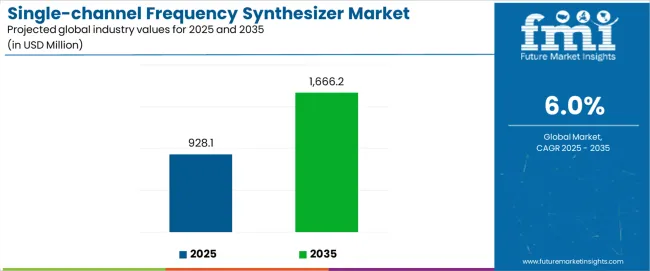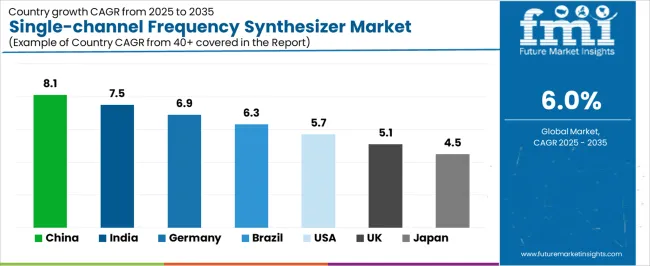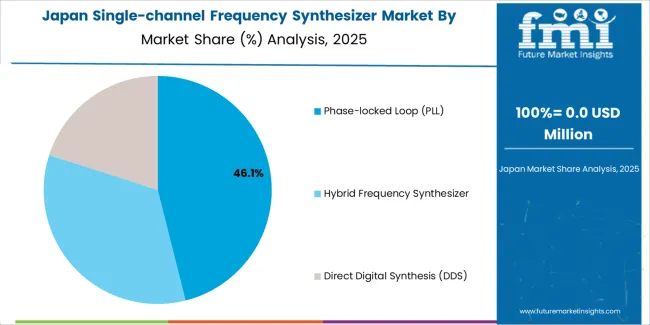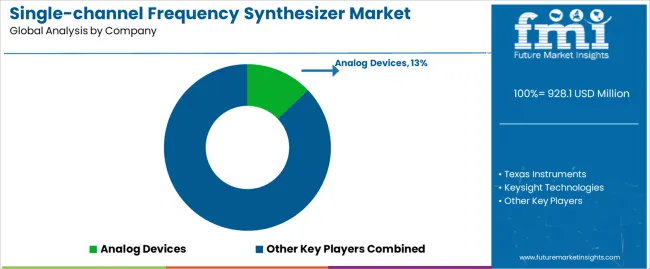The global single-channel frequency synthesizer market is valued at USD 928.1 million in 2025 and is set to reach USD 1,662.2 million by 2035, growing at a CAGR of 6.0%. The single-channel frequency synthesizer market stands at the forefront of a transformative decade that promises to redefine signal generation infrastructure and frequency control excellence across communications, radar, aerospace, and test measurement sectors. The market's journey from USD 928.1 million in 2025 to USD 1,662.2 million by 2035 represents substantial growth, demonstrating the accelerating adoption of advanced digital synthesis solutions and sophisticated frequency control systems across telecommunications networks, defense applications, scientific instrumentation, and industrial automation operations.
The first half of the decade (2025 to 2030) will witness the single-channel frequency synthesizer market climbing from USD 928.1 million to approximately USD 1,200 million, adding USD 271.9 million in value, which constitutes 37% of the total forecast growth period. This phase will be characterized by the rapid adoption of high-resolution digital synthesis systems, driven by increasing demand for ultra-low phase noise performance and enhanced frequency agility requirements worldwide. Superior spectral purity and fast switching capabilities will become standard expectations rather than premium options.
The latter half (2030 to 2035) will witness accelerated growth from USD 1,200 million to USD 1,662.2 million, representing an addition of USD 462.2 million or 63% of the decade's expansion. This period will be defined by mass market penetration of integrated multi-function systems, integration with comprehensive software-defined radio platforms, and seamless compatibility with existing RF infrastructure. The single-channel frequency synthesizer market trajectory signals fundamental shifts in how telecommunications operators and defense contractors approach frequency generation solutions, with participants positioned to benefit from sustained demand across multiple application segments.

The single-channel frequency synthesizer market demonstrates distinct growth phases with varying market characteristics and competitive dynamics. Between 2025 and 2030, the single-channel frequency synthesizer market progresses through its advanced digital integration phase, expanding from USD 928.1 million to USD 1,200 million with steady annual increments averaging 5.3% growth. This period showcases the transition from basic PLL architectures to advanced direct digital synthesis systems with enhanced resolution and integrated phase noise optimization becoming mainstream features.
The 2025 to 2030 phase adds USD 271.9 million to market value, representing 37% of total decade expansion. Market maturation factors include standardization of frequency resolution specifications, declining component costs for high-performance integrated circuits, and increasing system integrator awareness of premium synthesizer benefits reaching 85-90% effectiveness in signal generation applications. Competitive landscape evolution during this period features established manufacturers like Analog Devices and Texas Instruments expanding their product portfolios while new entrants focus on specialized software-defined solutions and enhanced frequency agility technology.
From 2030 to 2035, market dynamics shift toward advanced integration and multi-sector deployment, with growth accelerating from USD 1,200 million to USD 1,662.2 million, adding USD 462.2 million or 63% of total expansion. This phase transition logic centers on universal high-performance systems, integration with artificial intelligence optimization algorithms, and deployment across diverse application scenarios, becoming standard rather than specialized frequency generation formats. The competitive environment matures with focus shifting from basic frequency range to comprehensive phase noise performance and compatibility with modern software-defined radio operations.
At-a-Glance Metrics
| Metric | Value |
|---|---|
| $ Market Value (2025) | USD 928.1 million |
| $ Market Forecast (2035) | USD 1,662.2 million |
| # Growth Rate | 6.00% CAGR |
| Leading Technology Type | Phase-locked Loop (PLL) |
| Primary Application | Communications Segment |
The single-channel frequency synthesizer market demonstrates strong fundamentals with PLL systems capturing a dominant share through superior frequency stability characteristics and cost-effective manufacturing capabilities. Communications applications drive primary demand, supported by increasing 5G network deployment requirements and enhanced signal generation management solutions. Geographic expansion remains concentrated in developed markets with established telecommunications infrastructure, while emerging economies show accelerating adoption rates driven by digital transformation projects and rising connectivity demands.
The single-channel frequency synthesizer market represents a compelling intersection of RF innovation, semiconductor technology advancement, and signal generation optimization management. With robust growth projected from USD 928.1 million in 2025 to USD 1,662.2 million by 2035 at a 6.00% CAGR, this market is driven by increasing 5G deployment expansion trends, defense modernization requirements, and industrial demand for precise frequency control formats.
The single-channel frequency synthesizer market's expansion reflects a fundamental shift in how telecommunications operators and defense contractors approach signal generation infrastructure. Strong growth opportunities exist across diverse applications, from communications systems requiring ultra-stable frequency references to aerospace applications demanding radiation-hardened solutions. Geographic expansion is particularly pronounced in Asia-Pacific markets, led by China (8.1% CAGR) and India (7.5% CAGR), while established markets in North America and Europe drive innovation and specialized segment development.
The dominance of PLL systems and communications applications underscores the importance of proven frequency synthesis technology and phase noise performance in driving adoption. Integration complexity and power consumption remain key challenges, creating opportunities for companies that can deliver consistent performance while maintaining energy efficiency.
Market expansion rests on three fundamental shifts driving adoption across telecommunications and defense sectors. 5G network deployment creates compelling advantages through frequency synthesizer systems that provide comprehensive signal generation with multi-band compatibility, enabling telecommunications operators to manage complex modulation schemes and maintain signal quality standards while ensuring efficient spectrum utilization and justifying investment over legacy oscillator methods. Defense modernization accelerates as military organizations worldwide seek reliable RF systems that deliver operational superiority directly to radar operations, enabling threat detection that aligns with national security expectations and maximizes electronic warfare capabilities. Technology advancement drives adoption from electronics manufacturers requiring precise frequency control that maximizes system performance while maintaining phase noise specifications during critical measurement and communication operations.
The growth faces headwinds from component supply chain constraints that differ across semiconductor suppliers regarding availability and lead time consistency, potentially limiting production scalability in high-demand application categories. Integration complexity also persists regarding software compatibility and calibration requirements that may increase development costs in markets with demanding performance protocols.
Primary Classification: The single-channel frequency synthesizer market segments by technology type into Direct Digital Synthesis (DDS), Phase-locked Loop (PLL), and Hybrid categories, representing the evolution from basic analog synthesis to advanced digital-controlled formats for comprehensive frequency generation operations.
Secondary Breakdown: Application segmentation divides the single-channel frequency synthesizer market into communications, radar, test and measurement, aerospace, and other sectors, reflecting distinct requirements for frequency stability, switching speed, and phase noise performance.
Regional Classification: Geographic distribution covers Asia Pacific, North America, Europe, Latin America, and the Middle East & Africa, with developed markets leading innovation while emerging economies show accelerating growth patterns driven by telecommunications infrastructure development programs.
The segmentation structure reveals technology progression from standard PLL architectures toward integrated digital synthesis platforms with enhanced resolution and agility capabilities, while application diversity spans from telecommunications operations to aerospace systems requiring comprehensive frequency control and ultra-stable reference solutions.
Phase-locked Loop (PLL) segment is estimated to account for 48% of the single-channel frequency synthesizer market share in 2025. The segment's leading position stems from its fundamental role as a critical component in frequency synthesis applications and its extensive use across multiple telecommunications and defense sectors. PLL's dominance is attributed to its superior frequency stability characteristics, including excellent phase noise performance, reliable frequency tracking, and balanced cost-effectiveness that make it indispensable for modern RF system operations.
Market Position: PLL systems command the leading position in the single-channel frequency synthesizer market through advanced integrated circuit technologies, including comprehensive loop filter optimization, voltage-controlled oscillator integration, and reliable phase detection performance that enable designers to deploy frequency synthesis solutions across diverse application environments.
Value Drivers: The segment benefits from system integrator preference for proven synthesis architectures that provide exceptional stability without requiring premium development costs. Mature manufacturing processes enable deployment in communications equipment, radar systems, and test instruments where frequency accuracy and cost efficiency represent critical selection requirements.
Competitive Advantages: PLL systems differentiate through excellent frequency resolution, proven phase noise performance, and compatibility with standard RF design methodologies that enhance signal generation capabilities while maintaining economical component profiles suitable for diverse frequency synthesis applications.
Key market characteristics:
Communications segment is projected to hold 62% of the single-channel frequency synthesizer market share in 2025. The segment's market leadership is driven by the extensive use of frequency synthesizers in telecommunications infrastructure, 5G base stations, satellite communications, and wireless systems, where precision frequency generation serves as both a signal source and reference solution. The communications sector's consistent demand for reliable frequency synthesis supports the segment's dominant position.
Market Context: Communications applications dominate the single-channel frequency synthesizer market due to widespread adoption of advanced modulation schemes and increasing focus on spectrum efficiency, phase noise optimization, and frequency agility that enhance network performance while maintaining signal quality standards.
Appeal Factors: Telecommunications operators prioritize frequency accuracy, fast switching speeds, and integration with software-defined radio platforms that enable coordinated deployment across multiple frequency bands. The segment benefits from substantial 5G infrastructure investment and network modernization that emphasizes reliable frequency synthesis systems for cellular and fixed wireless applications.
Growth Drivers: Mobile network operators incorporate frequency synthesizers as standard components for base station equipment and small cell deployments. At the same time, satellite communication initiatives are increasing demand for precision frequency references that comply with regulatory standards and enhance system performance.
Market Challenges: Component supply chain constraints and integration complexity may limit deployment flexibility in cost-sensitive markets or regions with varying certification requirements.
Application dynamics include:
Growth Accelerators: 5G network deployment drives primary adoption as frequency synthesizer systems provide exceptional signal generation capabilities that enable telecommunications without phase noise degradation, supporting network performance improvement and spectral efficiency that require reliable RF components. Defense modernization accelerates market expansion as military organizations seek precise frequency control that maintains operational superiority during radar operations while enhancing electronic warfare capabilities through advanced synthesis technologies and compatibility. Technology advancement increases worldwide, creating sustained demand for high-resolution frequency generation systems that complement RF design requirements and provide operational advantages in signal processing efficiency.
Growth Inhibitors: Component supply chain volatility challenges differ across semiconductor markets regarding availability and lead time consistency, which may limit production scalability and delivery predictability in high-volume application categories with demanding timeline requirements. Integration complexity persists regarding software compatibility and calibration standards that may increase development costs in applications with strict performance protocols. Market fragmentation across multiple frequency band specifications and interface standards creates compatibility concerns between different system architectures and existing RF infrastructure.
Market Evolution Patterns: Adoption accelerates in telecommunications and defense sectors where performance benefits justify component investments, with geographic concentration in developed markets transitioning toward mainstream adoption in emerging economies driven by digital infrastructure and connectivity development. Technology advancement focuses on enhanced integration density, improved phase noise performance, and compatibility with software-defined architectures that optimize signal generation capabilities and design flexibility. The single-channel frequency synthesizer market could face disruption if alternative frequency generation methods or semiconductor innovations significantly challenge traditional synthesizer advantages in RF applications.
The single-channel frequency synthesizer market demonstrates varied regional dynamics with growth leaders including China (8.1% CAGR) and India (7.5% CAGR) driving expansion through telecommunications infrastructure growth and defense modernization. Steady Performers encompass Germany (6.9% CAGR), Brazil (6.3% CAGR), and the USA (5.7% CAGR), benefiting from established RF ecosystems and advanced technology adoption.

| Country | CAGR (2025-2035) |
|---|---|
| China | 8.1% |
| India | 7.5% |
| Germany | 6.9% |
| Brazil | 6.3% |
| USA | 5.7% |
| UK | 5.1% |
| Japan | 4.5% |
Regional synthesis reveals Asia-Pacific markets leading growth through telecommunications expansion and defense investment, while European countries maintain steady expansion supported by industrial applications and research requirements. North American markets show strong growth driven by defense spending and 5G infrastructure development.
China establishes regional leadership through massive 5G network deployment and comprehensive telecommunications infrastructure modernization, integrating advanced frequency synthesizer systems as standard components in base station equipment and network infrastructure operations. The country's 8.1% CAGR through 2035 reflects telecommunications investment promoting network density and digital infrastructure development that mandate the use of high-performance frequency generation systems in communication operations. Growth concentrates in major metropolitan areas, including Beijing, Shanghai, and Shenzhen, where telecommunications networks showcase integrated synthesizer systems that appeal to equipment manufacturers seeking enhanced signal quality and international performance standards.
Chinese manufacturers are developing innovative frequency synthesizer solutions that combine local production advantages with international quality specifications, including direct digital synthesis and advanced phase-locked loop capabilities.
Strategic Market Indicators:
The Indian market emphasizes telecommunications applications, including extensive 4G/5g network development and comprehensive digital infrastructure expansion that increasingly incorporates frequency synthesizers for cellular base stations and microwave backhaul applications. The country is projected to show a 7.5% CAGR through 2035, driven by massive connectivity initiatives under Digital India programs and telecom operator demand for standardized, high-performance signal generation systems. Indian telecommunications facilities prioritize cost-effectiveness with frequency synthesizers delivering operational efficiency through economical component usage and reliable performance capabilities.
Technology deployment channels include major telecommunications operators, defense organizations, and electronics manufacturers that support high-volume usage for domestic and international applications.
Performance Metrics:
The German market emphasizes advanced frequency synthesizer features, including precision RF technologies and integration with comprehensive test and measurement platforms that manage industrial applications, automotive systems, and research operations through unified signal generation systems. The country is projected to show a 6.9% CAGR through 2035, driven by Industry 4.0 initiatives under manufacturing modernization trends and research institution demand for premium, reliable frequency control systems. German facilities prioritize precision with frequency synthesizers delivering comprehensive signal generation through enhanced phase noise performance and operational innovation.
Technology deployment channels include major automotive manufacturers, research institutes, and test equipment companies that support custom development for precision operations.
Performance Metrics:
In São Paulo, Rio de Janeiro, and Brasília, Brazilian telecommunications operators and defense contractors are implementing advanced frequency synthesizer systems to enhance communications capabilities and support operational efficiency that aligns with network modernization protocols and equipment standards. The Brazilian market demonstrates sustained growth with a 6.3% CAGR through 2035, driven by telecommunications expansion programs and defense investments that emphasize reliable signal generation systems for cellular and satellite applications. Brazilian facilities are prioritizing frequency synthesizer systems that provide exceptional stability while maintaining compliance with regulatory standards and minimizing integration complexity, particularly important in telecommunications infrastructure and defense communication operations.
Market expansion benefits from government programs that mandate enhanced performance in communications specifications, creating sustained demand across Brazil's telecommunications and defense sectors, where frequency accuracy and system reliability represent critical requirements.
Strategic Market Indicators:
The USA market emphasizes cutting-edge frequency synthesizer deployment, growing at 5.7% CAGR, with documented operational excellence in defense applications and telecommunications systems through integration with existing RF infrastructure and advanced signal processing systems. The country leverages engineering expertise in semiconductor manufacturing and RF design to maintain market leadership. Technology centers, including silicon Valley, Boston, and Austin, showcase advanced installations where frequency synthesizer systems integrate with comprehensive software-defined radio platforms and test systems to optimize signal generation and measurement accuracy.
American defense contractors and telecommunications companies prioritize frequency precision and phase noise performance in product selection, creating demand for premium frequency synthesizer systems with advanced features, including ultra-low phase noise and integration with automated calibration protocols. The market benefits from established defense infrastructure and willingness to invest in specialized RF technologies that provide superior signal quality and regulatory compliance.
Market Intelligence Brief:
The UK market showcases consistent frequency synthesizer adoption, with a 5.1% CAGR through 2035, emphasizing telecommunications infrastructure and defense applications where reliable signal generation supports network operations and military communications. British telecommunications operators and defense contractors prioritize frequency synthesizers that integrate seamlessly with existing RF systems while providing enhanced performance capabilities for 5G networks and radar applications.
The single-channel frequency synthesizer market benefits from strong research and development initiatives in universities and government laboratories, creating demand for precision frequency synthesizers in scientific and defense applications. London, Cambridge, and Edinburgh serve as key technology hubs where frequency synthesizer integration supports advanced telecommunications and aerospace programs.
Performance Metrics:

Japan's sophisticated electronics market demonstrates meticulous frequency synthesizer deployment, growing at 4.5% CAGR, with documented operational excellence in test and measurement applications and telecommunications systems through integration with existing precision instrumentation and quality assurance infrastructure. The country leverages engineering expertise in semiconductor manufacturing and RF circuit design to maintain market leadership. Technology centers, including Tokyo, Osaka, and Nagoya, showcase advanced installations where frequency synthesizer systems integrate with comprehensive test platforms and measurement systems to optimize signal generation and instrumentation accuracy.
Japanese electronics manufacturers prioritize frequency precision and measurement accuracy in product selection, creating demand for premium frequency synthesizer systems with advanced features, including ultra-high resolution and integration with automated test protocols. The single-channel frequency synthesizer market benefits from established electronics infrastructure and willingness to invest in specialized RF technologies that provide superior measurement capabilities and manufacturing compliance.
Market Intelligence Brief:
The single-channel frequency synthesizer market in Europe is projected to grow from USD 251 million in 2025 to USD 378 million by 2035, registering a CAGR of 4.2% over the forecast period. Germany is expected to maintain its leadership position with a 42.3% market share in 2025, declining slightly to 41.8% by 2035, supported by its automotive excellence and major manufacturing centers, including Bavaria and North Rhine-Westphalia.
France follows with a 22.1% share in 2025, projected to reach 22.8% by 2035, driven by comprehensive aerospace programs and telecommunications infrastructure initiatives. The United Kingdom holds a 18.7% share in 2025, expected to maintain 19.1% by 2035 through established defense sectors and telecommunications adoption. Italy commands a 9.2% share, while Spain accounts for 5.8% in 2025. The Rest of Europe region is anticipated to gain momentum, expanding its collective share from 1.9% to 2.7% by 2035, attributed to increasing digital transformation in Nordic and Eastern European countries and emerging telecommunications programs implementing advanced RF systems.

The single-channel frequency synthesizer market operates with moderate concentration, featuring approximately 15-20 participants, where leading companies control roughly 55-62% of the global market share through established distribution networks and comprehensive product portfolio capabilities. Competition emphasizes phase noise performance, frequency resolution, and integration flexibility rather than premium feature rivalry.
Market leaders encompass Analog Devices, Texas Instruments, and Keysight Technologies, which maintain competitive advantages through extensive semiconductor manufacturing expertise, global distribution networks, and comprehensive technical support capabilities that create customer loyalty and support design requirements. These companies leverage decades of RF circuit experience and ongoing integrated circuit technology investments to develop advanced frequency synthesizer systems with exceptional performance and integration features.
Specialty challengers include Mini-Circuits, Rohde & Schwarz, and Microchip Technology, which compete through specialized application innovation focus and efficient design solutions that appeal to system integrators seeking reliable performance formats and custom frequency planning flexibility. These companies differentiate through operational efficiency emphasis and specialized market focus.
Market dynamics favor participants that combine consistent signal generation performance with advanced design support, including evaluation tools and reference designs capabilities. Competitive pressure intensifies as traditional semiconductor manufacturers expand into frequency synthesizer systems. At the same time, specialized RF component suppliers challenge established players through innovative synthesis architectures and cost-effective integration targeting emerging telecommunications segments.
| Item | Value |
|---|---|
| Quantitative Units | USD 928.1 million |
| Technology Type | Direct Digital Synthesis (DDS), Phase-locked Loop (PLL), Hybrid |
| Application | Communications, Radar, Test and Measurement, Aerospace, Industrial, Others |
| End-User | Telecommunications Operators, Defense Contractors, Test Equipment Manufacturers, Aerospace Companies, Research Institutions |
| Frequency Range | Below 1 GHz, 1-6 GHz, 6-18 GHz, Above 18 GHz |
| Regions Covered | Asia Pacific, North America, Europe, Latin America, Middle East & Africa |
| Countries Covered | China, India, Germany, Brazil, U.S., U.K., Japan, and 25+ additional countries |
| Key Companies Profiled | Analog Devices, Texas Instruments, Keysight Technologies, Mini-Circuits, Rohde & Schwarz, Microchip Technology |
| Additional Attributes | Dollar sales by technology type and application categories, regional adoption trends across Asia Pacific, North America, and Europe, competitive landscape with semiconductor manufacturers and RF component suppliers, customer preferences for phase noise characteristics and frequency resolution, integration with software-defined radio equipment and test systems, innovations in direct digital synthesis technology and integrated PLL systems, and development of specialized frequency control solutions with enhanced agility and ultra-low phase noise features |
The global single-channel frequency synthesizer market is estimated to be valued at USD 928.1 million in 2025.
The market size for the single-channel frequency synthesizer market is projected to reach USD 1,666.2 million by 2035.
The single-channel frequency synthesizer market is expected to grow at a 6.0% CAGR between 2025 and 2035.
The key product types in single-channel frequency synthesizer market are phase-locked loop (pll) , hybrid frequency synthesizer and direct digital synthesis (dds).
In terms of application, communications segment to command 62.0% share in the single-channel frequency synthesizer market in 2025.






Full Research Suite comprises of:
Market outlook & trends analysis
Interviews & case studies
Strategic recommendations
Vendor profiles & capabilities analysis
5-year forecasts
8 regions and 60+ country-level data splits
Market segment data splits
12 months of continuous data updates
DELIVERED AS:
PDF EXCEL ONLINE
Frequency Control & Timing Device Market Growth – Forecast 2024-2034
Frequency Converter Market Growth – Trends & Forecast 2024-2034
Frequency Counter Market Growth – Trends & Forecast 2019-2027
Global Low Frequency Ultrasound Market Analysis – Size, Share & Forecast 2025-2035
Low Frequency Sound Absorbing Insulation Material Market Growth – Trends & Forecast 2024-2034
High Frequency Chest-Wall Oscillation Devices Market Size and Share Forecast Outlook 2025 to 2035
Dual Frequency Ultrasonic Cleaner Market Size and Share Forecast Outlook 2025 to 2035
High Frequency Military Communications Market Size and Share Forecast Outlook 2025 to 2035
Radiofrequency (RF) Ablation System Market Size and Share Forecast Outlook 2025 to 2035
Radiofrequency Balloon Catheter Market Size and Share Forecast Outlook 2025 to 2035
High Frequency High Speed Copper Clad Laminate CCL Market Size and Share Forecast Outlook 2025 to 2035
High Frequency Vibrator Market
Radio Frequency Identification Market Size and Share Forecast Outlook 2025 to 2035
Radio Frequency Test Equipment Market Size and Share Forecast Outlook 2025 to 2035
Radio Frequency Front End Module Market Size and Share Forecast Outlook 2025 to 2035
Radio Frequency Beauty Equipment Market is segmented by product, application, technology, and end user from 2025 to 2035
Radio Frequency Components Market Growth – Trends & Forecast 2025 to 2035
Radio Frequency Integrated Circuit (RFIC) Market Analysis by Product, Application and Region Through 2035
Variable Frequency Drive Market Growth – Trends & Forecast 2024-2034
Digital Radio Frequency Memory (DRFM) Market Size and Share Forecast Outlook 2025 to 2035

Thank you!
You will receive an email from our Business Development Manager. Please be sure to check your SPAM/JUNK folder too.
Chat With
MaRIA